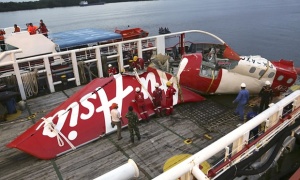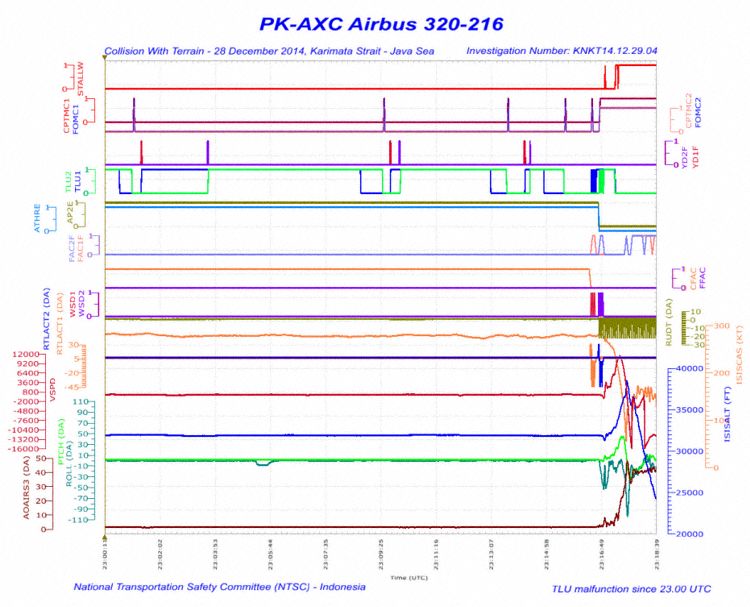It’s been a tough week for air travelers concerned about safety – the FAA downgraded Thailand over safety concerns (read my report and advice here) and now, the final report of the crash investigation of AirAsia Indonesia flight QZ8501 has been issued: The cause of the crash causing 162 deaths was a mix of a airplane parts issue, airplane maintenance and ultimately pilot error in handling the situation. Read my analysis of the report and my advice on choosing your airline in the future below!
Having flown AirAsia Indonesia and traveling a lot in the region, this incident is close to my heart and I read a lot of news of this report over the last few days. A lot of the information is very simplified and confusing, so I read the original NTSC release as well as subsequent analysis to understand what really happened, beyond the catchy media headlines. It’s a long post, so if you are in a hurry, you can jump to the bottom of the post for the conclusion! Otherwise, here are the details how the crash developed:
- Weather
The weather was bad during the flight and QZ8501 had requested (and received) approval to go around and above a severe thunderstorm. While the bad weather was the backdrop to the accident, it is typical for this region and it didn’t cause any damage to the plane or contribute to the crash.

- Faulty Part
 The Flight Data Recorder showed that the Rudder Travel Limiter (RTL, a safety device to limit the maximum rudder use) had failed due to a cracked solder joint on the electronics board, causing 5 alert messages during the flight! The crack is visible to the naked eye and an aviation engineer commented on a discussion board that any trained mechanic should be able to spot the issue on inspection and could fix it or replace it in less than 10 minutes!
The Flight Data Recorder showed that the Rudder Travel Limiter (RTL, a safety device to limit the maximum rudder use) had failed due to a cracked solder joint on the electronics board, causing 5 alert messages during the flight! The crack is visible to the naked eye and an aviation engineer commented on a discussion board that any trained mechanic should be able to spot the issue on inspection and could fix it or replace it in less than 10 minutes! - Failure of Maintenance System
One of the most concerning parts of the report is that this was not a sudden system failure, but that there had been 23 occurrences of problems with this board on this aircraft in the last 12 months, with the intervals of occurrence becoming shorter in the last 3 months. In fact, the same pilot had experienced the same problem 3 days prior to the crash on this very plane – and maintenance only reset the computer, rather than inspecting the board to find the root cause of the issue!
So, there was a clear and repeated warning that something was wrong with this plane, yet none of the different maintenance engineers did the necessary inspection and fix/replace the part! A problem that re-occurs 23 times is not a “glitch”! The cost and time required are minimal! It’s shocking that the plane was returned to operations over and over without action being taken! This was not one human error or oversight, it was a repeated and systemic maintenance failure! - Handling of the upset I – Response to Alert
The crew handled the first three alerts of the RTL failure according to the aircraft manual, but after the 4th alert the crew decided to pull the breaker and reset the flight computer. That’s the equivalent of rebooting your Windows PC when you have a computer problem and, for an airplane, is typically done on the ground, but against policy when in flight! The reset turns of the auto pilot, returning the plane to fully manual control without automated safety limiters (like excessive rudder, too slow speed, etc).
So, the crew violated procedure by turning of the flight computer in mid-flight. That in itself is not fatal – the flight computer can fly the plane (and does most of the time), but manual control by the pilot is not a reason for the plane to crash. Any crew should be able to take-off, fly and land a plane manually!
- Handling of the upset II – Manual Control
And then things went terribly wrong: the crash report for QZ8501 states that the rudder was turned 2 degrees, with the plane banking at 54 degrees. That’s a very noticeable bank (up to 45 degrees is considered “normal”), yet the crew did not respond for 9 seconds after turning off the auto pilot. And when the co-pilot finally did respond, things got worse: the plane started to stall. A stall basically means that the plane stops flying because it is too slow for the air to flow around the wings and “carry” it. There is early warning and pilots (including these two) are trained to respond to the warnings and avoid a stall by increasing the speed (pushing down controls)! In this case, they didn’t respond appropriately and the plane stalled, dropping at high speed and steep angle. But even a stall doesn’t have to lead to a crash, if it occurs at high altitude – any commercial plane can recover with proper control inputs, returning to a normal airflow around the wing and stable flight! It turns out that the crew of QZ8501 was not trained to handle this type of upset and was not able to take the necessary action to recover from the stall!
So, it is unbelievable to me that AirAsia Indonesia didn’t train their pilots to handle upsets – even I learned how to handle a stall when I got my sport pilot license for a paraglider! It’s one of the most basic emergency maneuvers and my flight training saved my life when I experienced a stall myself! Only training will ensure that you’ll react appropriately under the stress of an emergency! I’d expect somebody entrusted with the lives of so many people to have that kind of training. And I find AirAsia’s response that the Airbus manual doesn’t require upset training disingenuous, because that manual also tells you not to turn off the flight computer in the air! AirAsia Indonesia didn’t brake the law by not providing the training, but their decision to save time and money on training was a contributor to the crash! - Handling of the upset III – Communication
According to the Cockpit Voice Recorder, the pilot ordered the co-pilot who was at the controls at the time, to “Pull Down”. That is a confusing instruction – the proper action would be to order “Push Down” (not “Pull Up”) to increase speed and avoid/end the stall condition. As a consequence, the co-pilot was pulling back full force on the stick, making it worse and causing the stall! The Pilot at the same time tried to control the plane and pushed down gently! Pilot and co-pilot didn’t follow procedure to announce “I have control” and ignored warnings that they were both trying to control the plane! Neither the Indonesian pilot nor the French co-pilot had English as their first language and this communication issue for the most basic flight commands appears to have contributed to the flight crews inability to recover and to prevent the crash of the plane!
So, there have been accidents of mixed language crews in the past, this is a known risk and avoidable! Requiring command of the English language to cover basic instructions should be minimum crew requirement, especially if you employ mixed language crews!
I have tried to provide my detailed review of the report in a less technical way to show what happened and to conclude what was fate/luck and what was avoidable. If you’d like to read more detail in the original version, you can read the official NTSC media release (that all the news are using) here and the full report and commentary from pilots and engineers here!
Conclusion: This crash started with the failure of an electronic part. We all have our gadgets and know that these things happen frequently. What is shocking that the maintenance process wasn’t able to detect and fix it, despite 23 occurrences over 12 months! This parts failure started a series of crew errors. They turned off the flight computer (against guidelines) without preparing for manual flight (co-pilot at controls, no action for 9 seconds despite steep bank). The plane entered a stall despite warning. They were not trained to handle upsets during manual flight, didn’t respond appropriately to the emergency and were not able to recover from the stall. Their communication issues made it worse. This combination of part failure, maintenance failure and crew errors caused AirAsia QZ8501 to crash with all 162 people on board!
Any airplane crash is tragic. What makes this crash even more sad is that it was not an act of terror, bad weather or a sudden, unexpected system failure, but an avoidable crash! While we’ll never know for sure, my conclusion from the report is that a better maintenance process and a better trained and more experienced crew could have prevented this terrible accident!
Similar to previous accidents, the learning from this accident will trigger improvements to airline safety around the world, resulting in additional safety measures on planes, better maintenance procedures and improved crew training! AirAsia Indonesia has already taken 51 safety actions to improve, hopefully preventing similar accidents in the future!
So, what can you do when planning your next trip? Despite these tragic accidents, flying is still the safest way to travel by a long shot. If you want to improve your transportation safety, wearing a helmet on your bike, not looking at your smartphone when crossing the street or wearing a seatbelt in your car will make much more of a difference with regards to safety than your choice of airlines. Flying continues to be safer than taking the bus, train or ferry, regardless of this tragic and very visible accidents! Read my Top tips how to travel Safely to find out more!
But you do have a choice in airlines and not all airlines are the same. There are differences in crew training, operating policies and maintenance procedures that all contribute to your safety! I publish safety ratings in all my airline reviews, for example the AirAsia Facts & Features, and you can find all commercial airlines on AirlineRatings. Keep in mind that their rating system heavily rates the safety of the country of the airline (3 out of 7) and only 4 out of 7 stars are under direct control of the airline. Also, a 7* rating doesn’t mean the airline is 7 times safer than a 1* airline – the likelihood of a crash is probably a tiny fraction of one percentage point higher on a lowly rated airline than on the highest rated ones! It DOES give you the best available, easiest to understand rating out there and I will continue to include it in my posts and recommend it for your consideration!
I recommend that you include safety information in your choice of carrier and not just price. I personally choose an airline with a higher safety score if there is only a “small” difference in fare and comfort. For me, it is more about the peace of mind than the actual, mathematically small reduction in risk of a crash. For example, on a flight from Bali, Indonesia, to Australia, I’d take Virgin Australia (7 out of 7*) over AirAsia Indonesia (1/7*) with the fare difference being 10s of dollars. Yet for a trip from Surabaya, Indonesia, to Bali, with a choice of Lion Air (1/7*), AirAsia (1/7*) and a ferry/bus, I’d pick Lion Air or AirAsia over the ferry/bus any day! We each have to decide if “small difference” means a few dollars or a few hundred dollars when we purchase a ticket and what we consider the minimum standard for any trip. So, please consider my airline reviews and the AirlineRatings in your travel plans, make informed buying decisions and travel safely!




Thank you for this article and for taking the time to write it
Thanks – I felt that there was a lot of media coverage on the crash – and then almost nothing on the final crash report… a crash like this is tragic – and it’s important that the industry improves afterwards!